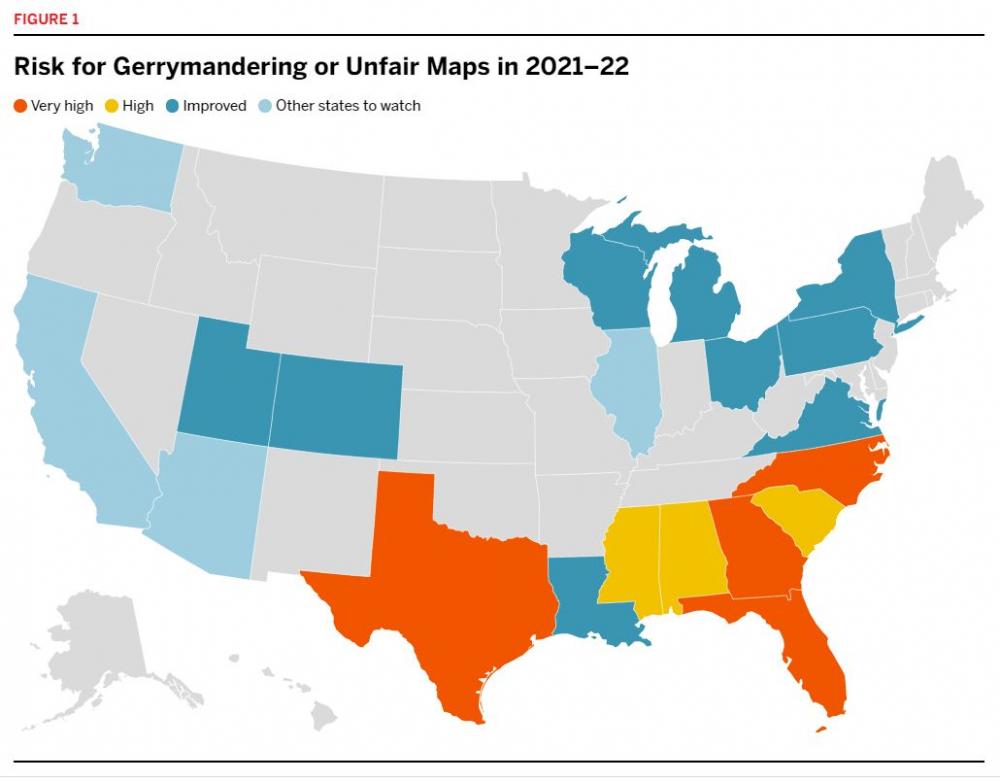The Redistricting Landscape, 2021–22

Under the best of circumstances, the redrawing of legislative and congressional districts every 10 years is a fraught and abuse-prone process. But the next round of redistricting in 2021 and 2022 will be the most challenging in recent history. Even before the Covid-19 pandemic, intense fights over representation and fair maps were all but certain in many states due to rapid demographic change and a weakening of the legal framework governing redistricting. Invariably, communities of color would bear much of the brunt, facing outright discrimination in some places and being used as a convenient tool for achieving unfair partisan advantage in others.
Covid-19, however, has further upended the redistricting cycle by delaying the release of data needed by states to draw maps, and in turn delaying redistricting.
This report looks at the upcoming redistricting cycle through the lens of four factors that will influence outcomes in each state: who controls map drawing; changes in the legal rules governing redistricting over the last decade; pressures from population and demographic shifts over the same period; and the potential impact of the Covid-19 pandemic on the 2020 Census. In each state, the confluence of these factors will determine the risk of manipulated maps or whether, conversely, the redistricting process will produce maps that reflect what voters want, respond to shifts in public opinion, and protect the rights of communities of color.
Expect a tale of two countries. In much of the country, newly enacted reforms and divided government will make it harder to force through partisan gerrymanders or racially discriminatory maps. In other states, however, there may be even greater room for unfair processes and results than in 2011, when the nation saw some of the most gerrymandered and racially discriminatory maps in its history.
Highlights: What’s New in 2021–22?
- Political changes and reforms: Single-party control of map drawing is by far the biggest predictor of redistricting abuses. For the next round of redistricting, the good news is that single-party control has decreased due to a combination of reforms and elections that have resulted in divided government. In total, six states have adopted redistricting reforms that will be used in the upcoming redistricting cycle, including Virginia in November 2020. Meanwhile, several other states where maps are still drawn by legislatures and that saw egregious gerrymandering last cycle now have divided governments. Lawmakers in these states must now compromise or forfeit their map drawing authority to the courts — where the likelihood of fair maps is much higher. The impact of these changes is especially notable at the congressional level: in the upcoming cycle, Republicans will have sole control over the drawing of just 181 congressional districts, compared with 213 districts after the 2010 elections. (The exact number of seats could change slightly depending on the results of the 2020 Census.)
- Legal changes: The legal landscape, by contrast, is more ominous this time around. Map drawing in 2021–22 will take place with a legal framework weakened by two major Supreme Court rulings. In 2013, the Supreme Court gutted core protections of the Voting Rights Act in Shelby County v. Holder. Then, in 2019, the Court closed the door to federal court challenges to partisan gerrymanders in Rucho v. Common Cause. But there is also hopeful news. The last decade saw new jurisprudential fronts open with wins against partisan gerrymandering in two state courts, suggesting that state constitutions could emerge as an alternative route to challenge gerrymandering in the 2021–22 cycle.
- Demographic and population changes: As has always been the case, population changes will be a crucial driver of redistricting abuses. The South in particular has grown rapidly and become both much more racially and politically diverse since 2011, threatening the long-standing political status quo. Similarly, some regions have seen population decreases or significant demographic changes and could also see battles over adjustments to maps. But while some parts of the country experienced major changes, large parts of the country were remarkably stable both in terms of demographics and population change, lowering the redistricting stakes and in turn reducing the gerrymandering risk.
- Census delays: As with so many areas of American life, Covid-19 has also roiled the next round of redistricting, creating uncertainty about when states will get the data they need to draw maps. Data delivery being delayed until next summer (as the Census Bureau at one point suggested) would cascade into delays to the map drawing process in many states — in some cases significantly. A number of states, including Iowa and Maine, would have to make constitutional or legal changes to avoid the process defaulting to the courts. States like Texas would be required to draw maps in a special session, where there typically are far fewer procedural protections and oversight opportunities. And Virginia would likely not have new maps in place in time for its 2021 legislative elections.
States to Watch

Legend Notes
- Highest-risk states: These states combine single-party political control of the redistricting process with extremely fast growth and demographic change. Additionally, for the first time in 50 years, they will not be required to obtain preapproval to use maps under Section 5 of the Voting Rights Act.
- Other high-risk states: These states, though they are not growing or changing demographically as fast as the highest-risk states, were formerly covered by Section 5 of the Voting Rights Act and will also draw maps this decade under single-party control.
- Likely improved states: These states adopted redistricting reforms in the last decade (though reforms could be challenged or ignored in some places) or saw political changes that mean map drawing will no longer be under a single party’s control.
- Other states to watch: These states saw significant nonwhite population growth in certain regions in the last decade and could see fights over increased representation demands for growing communities of color.
Click HERE to download the full report
Michael Li serves as senior counsel for the Brennan Center’s Democracy Program, where his work focuses on redistricting, voting rights, and elections. Prior to joining the Brennan Center, Li practiced law at Baker Botts L.L.P. in Dallas for ten years. He was the author of a widely cited blog on redistricting and election law issues that the New York Times called “indispensable.” He is a regular writer and commentator on election law issues, appearing on PBS Newshour, MSNBC, and NPR, and in print in the New York Times, Los Angeles Times, USA Today, Roll Call, Vox, National Journal, Texas Tribune, Dallas Morning News, and San Antonio Express-News, among others.
In addition to his election law work, Li previously served as executive director of Be One Texas, a donor alliance that oversaw strategic and targeted investments in nonprofit organizations working to increase voter participation and engagement in historically disadvantaged African American and Hispanic communities in Texas.
Li received his JD with honors from Tulane Law School and an undergraduate degree in history from the University of Texas at Austin.
The Brennan Center fights to make elections fair, end mass incarceration, and preserve our liberties — in Congress, the states, the courts, and the court of public opinion. Join us in building an America that is democratic, just, and free.
